Fossil Forests
The remains of ancient trees can help us better understand the effects of climate change on Earth.
By Emily Sohn
Fossil trees have a story to tell.
Earth has been around for about 4.5 billion years. The first traces of life appeared roughly 3.7 billion years ago. Land plants finally emerged more than 3 billion years later. Our immediate human ancestors showed up just 200,000 or so years ago.
Over eons, continents have collided and split apart. Islands have emerged and sunk. Icecaps have melted and refrozen. Earth’s climate has warmed and cooled. Thousands of species, including dinosaurs, dodo birds, and Neandertals, have come and gone.
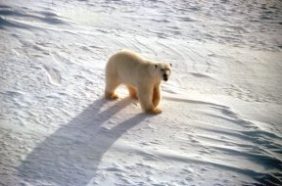 |
|
The Arctic is home to polar bears and other animals that can survive the cold and ice. About 45 million years ago, this region was warmer and wetter, with thick forests and animal life such as crocodiles and turtles. |
| U.S. Fish & Wildlife Service |
“Earth as we know it today is only a snapshot of what Earth can be and has been,” says Hope Jahren. She’s a geobiologist at Johns Hopkins University in Baltimore. “There have been many Earths and many biologies,” Jahren says.
Forty-five million years ago, for example, the Arctic was much warmer and wetter than it is now. At the time, during an epoch called the Eocene, huge trees grew in thick forests, providing homes to crocodiles, turtles, and other warm-weather animals.
Today, the region is so cold that only the hardiest creatures—polar bears, mosquitoes, and white hares—can survive. It’s a completely different world.
But the remains of ancient trees can tell us about these earlier times in Earth’s history—and provide previews of what may happen as Earth’s climate changes.
Arctic summers
For three summers in a row, Jahren, along with a group of students and colleagues, has spent several weeks at a time collecting tree fossils on Axel Heiberg Island in Canada. The island lies 1,000 miles north of Alaska and 700 miles from the North Pole. It boasts the best-preserved collection of wood fossils on the planet.
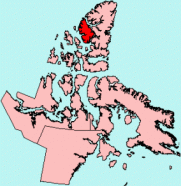 |
|
Axel Heiberg Island (shown in red) is one of the northernmost islands in Canada’s Arctic. |
| Wikipedia |
“There are thousands and thousands of trees just spilling out of the sediments,” Jahren says.
Most of the world’s tree fossils are petrified, which means that their soft plant tissues have turned into rock. On Axel Heiberg, however, ancient trees still look and feel like living wood. This amazing level of preservation allows scientists to analyze single cells, growth rings, and tissue that once carried water and nutrients through the trees.
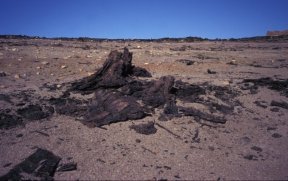 |
|
A fossil forest tree stump on Axel Heiberg Island, Canada. |
| Photo by Lyn Anglin, © Geological Survey of Canada |
One nice thing about trees is that, unlike animals, their tissues keep a detailed record of what conditions were like during their lifetimes, says paleoecologist Nan Arens of Hobart and William Smith Colleges in Geneva, N.Y. And the tissues can live for hundreds of years.
“Plants have tremendous power to tell us what the environment was like because they had to stand there and deal with it,” Arens says.
Jahren is using chemical analyses to measure the proportions of oxygen, carbon, hydrogen, and other elements in the Axel Heiberg fossils. These data reveal details about the water and soil in which the trees grew. This information also suggests what the climate was like at the time the trees were growing.
Combined with other types of data, these analyses show that the Arctic averaged about 13 degrees C (55 degrees F) during the Eocene. Now, temperatures on Axel Heiberg rarely rise above freezing, even in the summer, Jahren says.
Barren landscape
Modern visitors are struck by how barren, icy, and dry the northern landscape is. Long ago, however, the air was humid with water vapor and a heat-trapping gas called methane. Evergreen trees, similar to today’s redwoods and called metasequoia, grew to be 30 meters (100 feet) tall. And there was no ice. Instead, Jahren says, the environment probably resembled that of Seattle or San Francisco today.
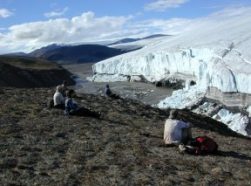 |
|
A group of students trekking on Axel Heiberg Island stop to admire a glacier. |
| Courtesy of Hope Jahren, Johns Hopkins University |
Jahren was excited to discover that Axel Heiberg’s metasequoia trees were deciduous. This means that their needles fell off every fall and grew back every spring.
Today, most trees with cones and needle-shaped leaves, called conifers, keep their leaves throughout their lives. The few species of conifers that are deciduous can live through seasons of extreme cold or drought. Under these conditions, photosynthesis (the process of turning light and carbon dioxide into food) is impossible. The trees save energy by losing and regrowing their needles every year.
It was neither cold nor dry in the Arctic during the Eocene, but trees there faced another problem: darkness. Near Earth’s North and South Poles, the sun does not rise for three straight months every year. Light is necessary for photosynthesis. So, Axel Heiberg’s metasequoias dropped their leaves to survive the dark winters.
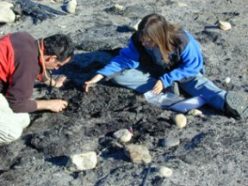 |
|
Looking for fossil trees on Axel Heiberg Island. |
| Courtesy of Hope Jahren, Johns Hopkins University |
Global warning
Unveiling the Arctic’s ancient secrets might help us predict how Earth will respond to today’s global warming. “We now have a better understanding of what a warmer world is potentially going to be like in the future,” Arens says.
As Earth’s atmosphere gets hotter, people and other life forms might suffer from floods and droughts. Crops that once grew in a certain area might not thrive in the warmer weather. It could get ugly.
Yet, as Arctic tree fossils show, life on Earth has been through such changes before. “It recovers from extinction,” Arens says. “Forests expand and contract.”
“It’s important to realize that Earth was different in the past,” she adds, “and it will be different in the future.”
Going Deeper:
Scientist’s Notebook: Working in the Arctic







